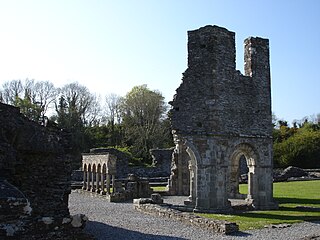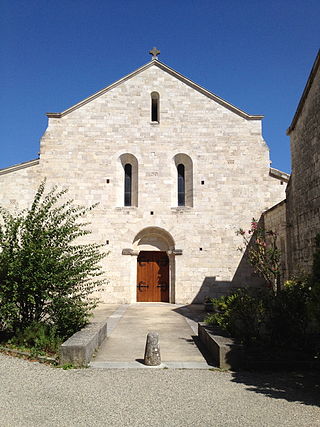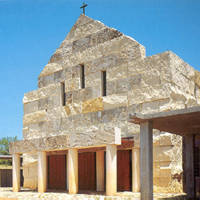
The Benedictines, officially the Order of Saint Benedict, are a mainly contemplative monastic order of the Catholic Church for men and for women who follow the Rule of Saint Benedict. Initiated in 529, they are the oldest of all the religious orders in the Latin Church. The male religious are also sometimes called the Black Monks, especially in English speaking countries, after the colour of their habits, although some, like the Olivetans, wear white. They were founded by Benedict of Nursia, a 6th-century Italian monk who laid the foundations of Benedictine monasticism through the formulation of his Rule. Benedict's sister, Scholastica, possibly his twin, also became a religious from an early age, but chose to live as a hermit. They retained a close relationship until her death.

The Trappists, officially known as the Order of Cistercians of the Strict Observance and originally named the Order of Reformed Cistercians of Our Lady of La Trappe, are a Catholic religious order of cloistered monastics that branched off from the Cistercians. They follow the Rule of Saint Benedict and have communities of both monks and nuns that are known as Trappists and Trappistines, respectively. They are named after La Trappe Abbey, the monastery from which the movement and religious order originated. The movement began with the reforms that Abbot Armand Jean le Bouthillier de Rancé introduced in 1664, later leading to the creation of Trappist congregations, and eventually the formal constitution as a separate religious order in 1892.
A commendatory abbot is an ecclesiastic, or sometimes a layman, who holds an abbey in commendam, drawing its revenues but not exercising any authority over its inner monastic discipline. If a commendatory abbot is an ecclesiastic, however, he may have limited jurisdiction.

The Abbey of Our Lady of Gethsemani is a Catholic monastery in the United States near Bardstown, Kentucky, in Nelson County. The abbey is part of the Order of Cistercians of the Strict Observance, better known as the Trappists. Founded on December 21, 1848, and raised to an abbey in 1851, Gethsemani is considered to be the motherhouse of all Trappist and Trappistine monasteries in the United States. Gethsemani is the oldest Trappist monastery in the country that is still operating.

Mellifont Abbey, was a Cistercian abbey located close to Drogheda in County Louth, Ireland. It was the first abbey of the order to be built in Ireland. In 1152, it hosted the Synod of Kells-Mellifont. After its dissolution in 1539, the abbey became a private manor house. This saw the signing of the Treaty of Mellifont in 1603 and served as William of Orange's headquarters in 1690 during the Battle of the Boyne.

Cistercian Preparatory School is a private school for boys located in Irving, Texas. The school follows the Cistercian tradition and offers a rigorous academic curriculum. Alongside a strong emphasis on character development and spiritual growth. Cistercian Preparatory School is renowned for its commitment to fostering intellectual curiosity, personal responsibility, and ethical leadership among its students.

Zirc Abbey, formerly also Zircz Abbey, also known as Zircensis or Boccon, is a Cistercian abbey, situated in Zirc in the Diocese of Veszprém, Hungary.

Wettingen-Mehrerau Abbey is a Cistercian territorial abbey and cathedral located at Mehrerau on the outskirts of Bregenz in Vorarlberg, Austria. Wettingen-Mehrerau Abbey is directly subordinate to the Holy See and thus forms no part of the Catholic Archdiocese of Salzburg. The abbot of Wettingen-Mehrerau, however, is a member of the Austrian Bishops' Conference. The official name of the abbey is Beatae Mariae Virginis de Maris Stella et de Augia Majore.

Our Lady of Bethlehem Abbey, also known as Portglenone Abbey, is a Cistercian monastery in Portglenone, County Antrim, Northern Ireland, founded in 1948 by the Cistercian community of Mount Melleray Abbey in County Waterford. The monks bought Portglenone House, a country mansion built c. 1810 by the Church of Ireland Bishop Dr. Alexander who demolished the local castle. History records that Sir Roger Casement often stayed in the house in the early years of the 20th century.

Aiguebelle Abbey is a Trappist monastery situated in the communes of Montjoyer and Réauville in the département of Drôme, on the borders of the Dauphiné and of Provence, France.

Tautra Abbey was a monastery of Cistercian monks founded in the 13th century on the island of Tautra in the Trondheimsfjord in Norway. The island is part of the municipality of Frosta in Trøndelag county, Norway. Tautra Abbey was dissolved during the Reformation in Scandinavia when its lands were passed to the Crown, but the sizeable ruins of the church are still to be seen. The ruins of the former abbey are relatively well preserved and are a favorite tourist destination.

Robert of Newminster was a priest, abbot, and a saint of the Catholic Church. He was born in Gargrave in Yorkshire, England. He was one of the monks who founded Fountains Abbey and is named from the abbey he founded in Morpeth, Northumberland.

Cistercian nuns are female members of the Cistercian Order, a religious order of the Catholic Church.

Brecht Abbey, also known as the Abbey of Our Lady of Nazareth, is an abbey of Trappistine nuns located in Brecht, in the Campine region of the province of Antwerp. Life in the abbey is characterized by prayer, reading and manual work, the three basic elements of Trappist life.
The Monastery of Our Lady of Jordan was a Strict Observance Cistercian (Trappist) monastery in the community of Jordan in Linn County, Oregon, United States, founded in 1904 and lasting for about six years.

Soleilmont Abbey is an abbey of Trappistine nuns situated in the forest and commune of Fleurus, at Gilly near Charleroi, Belgium, founded, according to tradition, in the 11th century, which became Cistercian in 1237. The nuns were expelled as a consequence of the French Revolution in 1796, but soon re-established themselves in 1802. The community became Bernardine in 1837, and Trappist in 1919.
The Southern Star Abbey, is a Cistercian monastery located in a remote, rural area of the North Island, New Zealand in the Diocese of Palmerston North. The monastery supports itself by operating a dairy farm. It is located at Kopua, between Takapau and Norsewood.

The Swiss-American Congregation is an association of Benedictine monasteries founded in 1881 in the United States, as a part of the international Benedictine Confederation of monasteries.

The Abbey of Our Lady of Dallas is a Cistercian monastery founded in 1955 in Irving, Texas. The monks of the abbey operate Cistercian Preparatory School for boys. As of 2018, it is currently the only Cistercian monastery left in North America, alongside the Canadian Abbey of Our Lady of Nazareth in Rougemont, Quebec.
Louis Julius Lekai, O.Cist. was an American monk, historian and university professor born in Hungary.

















